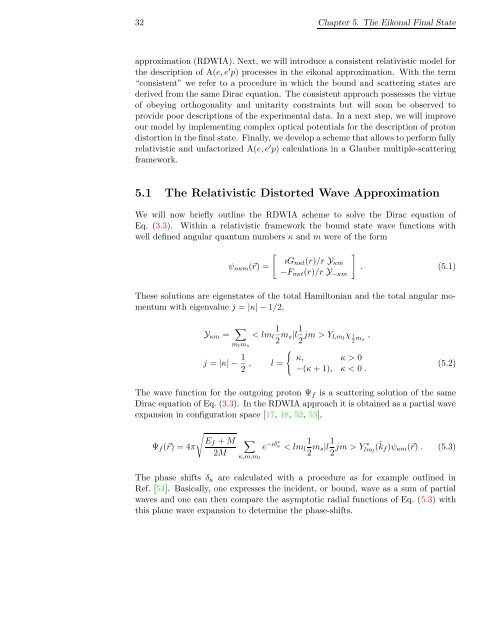Download Thesis in Pdf Format - Theoretical Nuclear Physics and ...
Download Thesis in Pdf Format - Theoretical Nuclear Physics and ...
Download Thesis in Pdf Format - Theoretical Nuclear Physics and ...
Create successful ePaper yourself
Turn your PDF publications into a flip-book with our unique Google optimized e-Paper software.
32 Chapter 5. The Eikonal F<strong>in</strong>al State<br />
approximation (RDWIA). Next, we will <strong>in</strong>troduce a consistent relativistic model for<br />
the description of A(e, e ′ p) processes <strong>in</strong> the eikonal approximation. With the term<br />
“consistent” we refer to a procedure <strong>in</strong> which the bound <strong>and</strong> scatter<strong>in</strong>g states are<br />
derived from the same Dirac equation. The consistent approach possesses the virtue<br />
of obey<strong>in</strong>g orthogonality <strong>and</strong> unitarity constra<strong>in</strong>ts but will soon be observed to<br />
provide poor descriptions of the experimental data. In a next step, we will improve<br />
our model by implement<strong>in</strong>g complex optical potentials for the description of proton<br />
distortion <strong>in</strong> the f<strong>in</strong>al state. F<strong>in</strong>ally, we develop a scheme that allows to perform fully<br />
relativistic <strong>and</strong> unfactorized A(e, e ′ p) calculations <strong>in</strong> a Glauber multiple-scatter<strong>in</strong>g<br />
framework.<br />
5.1 The Relativistic Distorted Wave Approximation<br />
We will now briefly outl<strong>in</strong>e the RDWIA scheme to solve the Dirac equation of<br />
Eq. (3.3). With<strong>in</strong> a relativistic framework the bound state wave functions with<br />
well def<strong>in</strong>ed angular quantum numbers κ <strong>and</strong> m were of the form<br />
ψ nκm (⃗r) =<br />
[ ]<br />
ıGnκt (r)/r Y κm<br />
−F nκt (r)/r Y −κm<br />
. (5.1)<br />
These solutions are eigenstates of the total Hamiltonian <strong>and</strong> the total angular momentum<br />
with eigenvalue j = |κ| − 1/2,<br />
Y κm = ∑ 1<br />
< lm l<br />
m l m s<br />
2 m s|l 1 2 jm > Y l,m l<br />
χ 1<br />
2 ms ,<br />
j = |κ| − 1 2 , l = {<br />
κ, κ > 0<br />
−(κ + 1), κ < 0 .<br />
(5.2)<br />
The wave function for the outgo<strong>in</strong>g proton Ψ f is a scatter<strong>in</strong>g solution of the same<br />
Dirac equation of Eq. (3.3). In the RDWIA approach it is obta<strong>in</strong>ed as a partial wave<br />
expansion <strong>in</strong> configuration space [17, 18, 52, 53],<br />
Ψ f (⃗r) = 4π<br />
√<br />
E f + M<br />
2M<br />
∑<br />
1<br />
e −ıδ∗ κ<br />
< lm l<br />
κ,m,m l<br />
2 m s|l 1 2 jm > Y lm ∗<br />
l<br />
(ˆk f )ψ κm (⃗r) . (5.3)<br />
The phase shifts δ κ are calculated with a procedure as for example outl<strong>in</strong>ed <strong>in</strong><br />
Ref. [54]. Basically, one expresses the <strong>in</strong>cident, or bound, wave as a sum of partial<br />
waves <strong>and</strong> one can then compare the asymptotic radial functions of Eq. (5.3) with<br />
this plane wave expansion to determ<strong>in</strong>e the phase-shifts.















